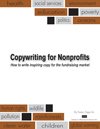Think you’re immune to “buyer’s remorse” because you’re a nonprofit? I have bad news for you. You have to deal with this just as the for-profit business sector does.
Buyer’s remorse is the regret, doubt, and second-guessing that a consumer experiences after purchasing a product or service. Think of it as a hidden objection.
As a nonprofit you also struggle with the buyer’s remorse syndrome. A better name might be “donor’s remorse” for charities, and “member’s remorse” or “joiner’s remorse” for professional or trade associations.
Before I discuss “hidden objections” it’s important for you to read yesterday’s post, Why people do NOT give to your charity. There I discussed the “obvious” objections to charitable giving.
Today’s topic on “hidden” objections continues where yesterday’s post ended. For the complete picture I suggest you read both.
Hidden Objections to Giving
As the name implies, hidden objections aren’t obvious. They’re not as easy to identify.
Hidden objections require more thought and investigation on your part. But you must address them. They are just as important – if not more so – as the obvious objections you listed after reading Tuesday’s post (9-14-10). Ignore them and you raise less money. Ignore them and you acquire fewer donors or members.
Here’s how hidden objections work:
As Mrs. Geneva Grand-Donor is reading your appeal she starts to visualize herself sending you money. Then she starts to think about what might happen AFTER she donates.
She starts to think about what may go wrong after you get her money.
Perhaps a few examples from everyday living will help you see what I mean:
1 – You buy a book for a friend. They don’t really like it and then they spill coffee on it. Now you can’t return it even though they don’t care for it. You’re stuck.
2 – You buy a house. Six months or a year after you move in they start bulldozing the woods adjacent to your property to build a school, or a shopping center.
3 – You buy a used car. Then what if you find a cheaper one later?
For nonprofits, identifying hidden objections can be more challenging. Exactly what they are depends partly on your mission. Therefore the list of objections can vary from one organization to another.
These are possibilities for charities:
Will they say thank you; or just take my money and run?
If I give, will I now get flooded with requests for more money every week? Will they also call me?
Will I hear anymore about this project and whether the school got built?
What if I name them in my will and after I’m gone . . . the charity collapses? My money is wasted. There’s no legacy.
These are possibilities for a professional association:
What if I don’t like it after I join? What if I never have time to use the benefits? Can I get my money back?
What if their future webinars and newsletters aren’t like the samples I saw? If I don’t like them, can I get a refund for my dues?
I join. I pay my $275 in dues and nothing happens. No new clients. No new business. I just wasted $275 and I’m stuck.
All these examples are generic. And you can add more that relate specifically to your mission and what you offer.
Bottom Line: In your fundraising appeals and invitations to join you must overcome both the obvious and the hidden objections to maximize response.
Brainstorm with your staff to identify ALL the objections for your organization. Also ask prospects and supporters one-on-one for their thoughts. This is because you’re too close to the cause to see all the objections prospects, donors and members experience.
Take what you learn and do your best to minimize “buyer’s remorse” for your nonprofit supporters. Address the obvious AND hidden objections in your copy (i.e., appeals, emails, web copy, etc.). Do this very well and you’ll enjoy higher response rates in your fundraising and membership efforts.
What hidden objection(s) does your nonprofit have? Please share them in the comments below.

{ 3 trackbacks }
{ 0 comments… add one now }